Introduction – Materials – Smock – Farthingale – Petticoat – Bodice – Skirtings – Rolled Sleeves – Overskirt – Forepart – Ruffs – Partlet and Sleeves – Jewelry making: Headdress; Necklace; Pelican Jewel; Sleeveband; Girdle; Wristbands; Fan – Finished gown – Funny Comments – Miss Starkie – Quiz
Come my lad.
|
The partlet and sleeves

(I’ve intentionally saved that part until the almost end of this dress diary so that
you are by now amazed by my work and won’t beat me too hard after reading this 😉 )
| Update August 2012:
Note that I made the partlet and sleeves in 2005. And just so that others may have it easier than I did in 2005, I’ve created a design on Spoonflower which actually imitates „stitched“ blackwork (by embroidering one repeat of the design, then digitizing that and turning it into a seamless repeat). Moreover, I’ve even created said design as Blackwork and Redwork – you can find my „mock Blackwork“ fabric and the „mock Redwork fabric“ on Spoonflower. Then again, of course, I do have a larger (and growing!) collection of Tudor / Elizabethan / Jacobean fabrics on Spoonflower; so you may just want to look at & consider those for your next Elizabethan garb project! 😉 ). |
I’m very patient, yes. In fact, I’m incredibly patient – someone once said that I must have „the patience of a saint“ to do what I do, when seeing my „Isabel“ doll gown, especially the stays.
However, I am by no means so patient to actually embroider the incredible blackwork of Elizabeth’s „Pelican“ partlet and sleeves – this would have taken until I’m very old and gray, I guess…. even *with* the embroidery machine I have…. so….. ahem…
…this is where the fine black permanent markers come into play.
I’ve cut the sleeves and partlet parts from the fine silk-linen batiste I had – a beautiful material, slightly crisp, yet soft; structure likely to silk organza – but not that stiff.
I then stretched each of those parts on my silk painting frame and… *ahem*…
….actually painted the blackwork designs from the portrait free hand with the permanent black markers on the fabric, giving the utmost care to actually imitate the embroidery stitches on the flowers.
Let me give a short statement on faking blackwork with permanent markers, as I did:
I know it’s probably not historical (but again – who can tell if some Vandyke gowns (= painter’s gowns which were used by painters for painting „templates“ for portraits, to which later the faces of the people actually portrayed were added) were not decorated just that way?).
Yes, I definitely agree that a gown like this would deserve real embroidery.
However – I am not planning on ever entering any competitions with this gown (basically because of the fact that where I live, we don’t have any possibilities for such competitions); and if I would, I could still use the narrow sleeves I cut from the forepart fabric and a different, actually embroidered – though not so elaborately – partlet.
But I wanted to have a similar design to the actual portrait partlet and sleeves embroidery, but could not afford the time to really embroider them – neither by hand nor by machine, which takes about as long as the hand embroidery as each design has to be programmed – by hand.
I am nevertheless quite proud of what I have managed to paint here.
As I have already said, the process of painting was also quite slow (though of course it did not take as long as actual hand embroidery), plus I now have a clothing item which is probably absolutely unique in design and style.
In other words: It’s mine, and I like it. I think I have put a considerable amount of work and time into those sleeves and partlet, and to me, both look beautiful; and someone looking at the gown would have to come closer than one yard’s distance to actually be able to tell that this is not blackwork embroidery but painted.
The painting process took a long time – I’ve had that frame in my kitchen for weeks, and each time I felt like it when passing it by, I painted some more flowers to it or changed the fabric in the frame when I had finished a piece.
I have written a short tutorial – or rather photographed it – on how to paint Tudor Roses by hand without a template; it can be found in the tutorials section of this site.
As I have painted the designs free hand, meaning with no template but the cover of „Queen Elizabeth’s Wardrobe unlock’d“ which was lying next to the frame all the time, not two flowers I have painted look the same.
The only template I made for myself, to make the placement of the designs easier, was to place some dots on the fabric in a diamond shape; here to be seen in the top area of the picture.
The seam running from left to right results from the fact that I had to piece the bit of batiste I had, so… this is the shoulder line seam.
I discovered at a later point of time that the pattern which I had in mind and which I therefore painted wasn’t exactly the pattern of the portrait gown’s partlet and sleeves – but at that point of time I had already painted one sleeve and was half finished with the partlet, so I just continued to paint the designs „my way“.
Now you may take a minute to picture me walking through town at night, one foot stepping on the pavement, the other on the street, wearing that gown, one hand clasping a bottle of wine, singing „My Way“ at the top of my lungs. I am in no way responsible for beverages or anything else now dripping from your computer screen.
Just to give you an example how much work the painting of these flowers was, I will give you a number.
As I have said, I have painted the fabric – *very* thin silk/linen fabric that would not take much color when painted – with fine black permanent fabric markers. These fabric markers *usually* hold, well, like forever if you always close them after use – especially on a very thin fabric, such as this batiste.
However, I needed no less than *three* markers for the painting of partlet and sleeves. I repeat: Three. This will perhaps give you an idea how many flowers, vines, leaves and buds I have in fact painted – I know that it’s quite difficult to determine that from just a few photographs, let alone the finished garment, which lets the fabric – as it’s bunched up – look much less than it actually is.
If you would also like to do something like this and like the designs I painted, but feel unable to draw something like this free hand, here are three pictures for you which you can enlarge to the size you need. I guess this would also make a fine blackwork template; except of course that the squares are missing.
The pictures are rather large in size; so please be patient while they load if you click on them:
Partlet (shoulder line runs from left to right (I’ve had to piece my small piece of silk-linen batiste for this along the shoulder line, otherwise I would not have had enough fabric), middle slash has not yet been made – front is on top, back is facing downwards; picture is slightly enhanced to make the pattern show better):
One sleeve:
The other sleeve:
Afterwards, I added a layer of white netting, decorated with golden bands over those painted batiste pieces:
This was to:
A) achieve an effect likely to what can be seen in the original portrait. There’s also netting and golden trimming over the actual blackwork sleeve and partlet – look at the portrait carefully, you can see the netting especially on the bottom portion of the sleeve on the right side; where the netting bunches up over the blackwork embroidered sleeves:
and
B) it gave me another nice effect: It’s now even less obvious that my blackwork was painted to the batiste, because the netting gives each of the lines an appearance of „stitching“ by separating the black, painted lines with fine white lines of netting:
The choice of netting was not so simple.
While the partlet in the Phoenix portrait clearly has some kind of ‚fishnet‘ over it:
the ‚Pelican‘ portrait’s netting is much finer; as to be seen above.
Now – tulle would have been a great choice, just that I find it too stiff. Plus, it has octagon shaped holes and this netting – no matter if the netting in the ‚Pelican‘ or ‚Phoenix‘ portrait – has diamond shaped holes.
After thinking about this for some time, I’ve incidentally found and bought a nice and soft mosquito net and cut my netting from it. I has a *very* small diamond shaped netting, much smaller than the one which was used on the Pelican gown’s partlet – the holes in the netting are no bigger than in tulle, just that they are no octagons but diamond shaped, so I liked this choice a lot.
See a bit of that netting draped over my hand so that you might get an impression how small the diamond netting holes are:
I then did another, perhaps not-so-historical thing with those sleeves- and partlet double layers of painted batiste and golden trimmed mosquito netting – I’ve sewn them together, *all* together; so basically this is a partlet with sleeves.
Just to repeat it, this is no translation error: I have made a partlet with sleeves.
On the other hand – who can say that this is absolutely not historical?
Please feel free to comment if you think that you have absolute proof that it was never done this way. And no, a „no surviving garment has this technique!“ is not considered absolute proof. Please also comment if you think that it *could* have been done just that way 😉
From what I see in the „Pelican“ portrait, it’s absolutely possible – as I have said, please feel free to comment, agree or disagree on that subject 🙂
The borders were decorated with some black lace I still had in storage, then over-embroidered with a golden lace:
And this is what the partlet-sleeve-combination looks like when put over the corset and the smock on a dress mannequin. I’ve pinned the wide fluffy sleeves to the narrow sleeves of the smock plus pinned one sleeve to the stays so that you can see the actual shape of the whole garment as if it was worn by a person. I will have to change the rather thick golden drawstring to a thinner one, though:
Now let’s move on to the jewelry making, which has a very own chapter and different pages in this web.
Navigation for this costume:
Introduction – Materials – Smock – Farthingale – Petticoat – Bodice – Skirtings – Rolled Sleeves – Overskirt – Forepart – Ruffs – Partlet and Sleeves – Jewelry making: Headdress; Necklace; Pelican Jewel; Sleeveband; Girdle; Wristbands; Fan – Finished gown – Funny Comments – Miss Starkie – Quiz



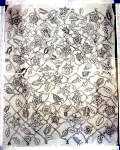
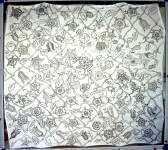
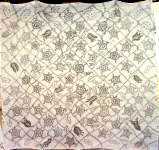
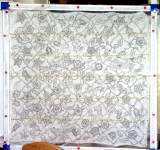

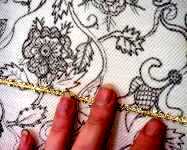
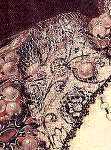
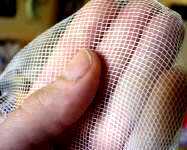
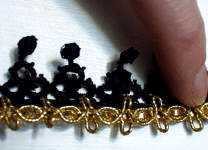



I made my first partlet with the sleeves attached due to time constraints, and it looked pretty fab. I don’t have any evidence that sleeves might have been sewn to the partlet, but it makes logical sense to me that one might have some „everyday“ partlets with the sleeves pre-attached for ease of wearing–and that these would be the garments that would wear out more rapidly. And it’s not like the Elizabethans didn’t know how to attach sleeves, I mean, since they’re on like every smock ever. Personally, I think yours looks absolutely fabulous that way, and why would you ever WANT to switch out the sleeves for it?